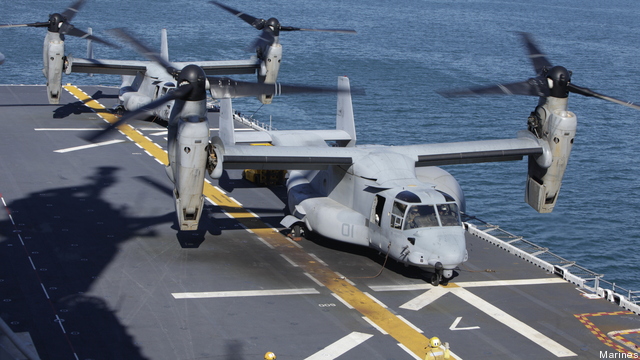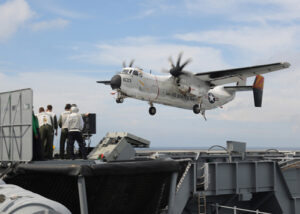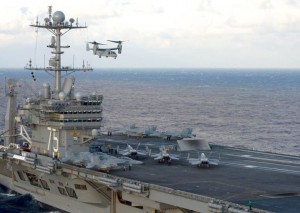
CRYSTAL CITY: Nudge nudge, wink wink, we love V-22s, Navy officials said here today. We couldn’t possibly confirm the Breaking Defense report that the service’s 2016 budget request buys V-22 Ospreys for the Carrier Onboard Delivery mission, they said, but if hypothetically the Navy happened to choose the V-22 to shuttle people and supplies to ships at sea, it would be a brilliant idea.

Navy Sec. Ray Mabus
“I know a memorandum has become public before the budget,” Ray Mabus said this morning at the annual Surface Navy Association conference. That’s something the Navy Secretary can’t discuss until his boss, Barack Obama, formally unveils the budget in February — not if Mabus values his job — but after refusing to talk about it, he promptly talked about it.
“One thing I will say about possible use of the V-22 is that is a great example of the Navy and Marine Corps team working together,” said Mabus, since the Osprey is already in widespread service with the Marines. “It’s also a great example of using a proven manufacturing process, a proven asset, to get lower cost, instead of starting over on a complete new system.”
“I’m not going to get out in front of things here with you guys,” Assistant Secretary Sean Stackley told reporters later, “but, very simply, an Analysis Of Alternatives was conducted.” (AOAs are a mandatory step of the procurement process). “It looked at everything from extending the service life of the current COD aircraft, building new aircraft or using the MV-22,” the Navy’s top procurement official continued. “[The AOA] came forward with recommendations [and] we are putting that into our 2016 budget request.”
Stackley didn’t say what the recommendations were, but after he described the three options, he hardly had to.

C-2 Greyhound
Option 1 is investing more money in an old car. That would be the C-2 Greyhound, designed in the 1960s and last produced in 1990, making the youngest Greyhound 25 years old. Derived from the E-2 Hawkeye reconnaissance aircraft, the C-2 is a fixed-wing propeller plane that shuttles between ship and shore. It’s got longer ranger, better speed, and more payload than helicopters, but it can’t land on anything smaller than an aircraft carrier. Hence the name, “carrier onboard delivery.”
The first problem with extending the C-2 is we don’t have enough of them already, Stackley said, and “extending the service life of those means taking a large number of them out of operation” for refit. “While there’re certain cost benefits [and] lower risk perhaps to doing that, there’s a downside in terms of the numbers of aircraft [available], the amount you would invest in extending the service life, and the number of years that you would get” out of an aging airframe, he said.
Option No. 2 would be a new aircraft, something not currently in US service: either bought from the world market and adapted or developed from scratch. “A new aircraft brings with it a degree of risk,” Stackley said. “[You’re either] choosing aircraft that might be available that don’t quite meet the mission…or taking the risk of design, development, etc. of a new aircraft.”
Option No. 3 would be the Osprey — and here the often-dour Stackley waxed visibly enthusiastic. “MV-22 is an aircraft that’s currently in production,” he began, using the Marine Corps designation. (MV-22 is the Marine variant; Air Force Special Operations uses the souped-up CV-22; the Navy version would be the HV-22). “You have an infrastructure,” Stackley said: training programs, spare parts, support services, and so on.

Sean Stackley
Operationally, Stackley went on, “it would be quite a change,” because unlike the C-2 — indeed, unlike any other aircraft in mass production — the “tilt-rotor” V-22 can take off and land vertically like a helicopter, then travel long distances with the speed and fuel efficiency of a turboprop airplane. That means a single V-22 can do a mission that currently would require both a C-2 and a helicopter to perform. Instead of only landing on the carrier, as with the current COD, V-22 could make runs directly to any ship with a large enough helicopter landing pad.
“It’s much more than a COD aircraft,” said Stackley. “Given all the capability of the V-22, all that other capability that you get, all the other ways you can employ that aircraft other than just as the COD,” he said, it would require rethinking the entire concept of operations for resupplying carrier strike groups by air.
The Navy and Marines have done “some work” on how to integrate the V-22 into the operations of the carrier air wing, and “there’s a lot of confidence that’s not going to be a problem,” Stackley said. Certainly, the carrier can accommodate it. “We use it on the LPD-17,” he said, an amphibious warship with a landing pad a fraction the size of a carrier deck. “If you can operate an MV-22 off an LPD-17, you can operate it off of a carrier, so that part of the risk is approximately zero.”

V-22 landing on an aircraft carrier.
In a ‘world first,’ DARPA project demonstrates AI dogfighting in real jet
“The potential for machine learning in aviation, whether military or civil, is enormous,” said Air Force Col. James Valpiani. “And these fundamental questions of how do we do it, how do we do it safely, how do we train them, are the questions that we are trying to get after.”


























